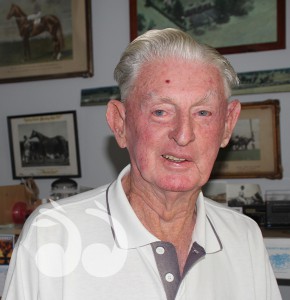Spring Fever is Coming
By Harley Walden

Harley Walden, racing coloumnist
SPRING, it’s that magical time of the year that the landscape breaks into new life, the native flowers in the bush the blossoms in the garden.
It is when the young at heart of all ages feel part of life and that time of year that us oldies start to discard those winter woollies.
While spring is welcomed by all there is one group in our society that feels the quickening of the pulse, the racegoers.
For the followers of the turf the word Spring has its own associations, the beginning of the new racing season, the arrival of the new young two year-olds, the return of the top class horses from the winter spelling paddocks and the first of the classic races leading up to the Spring Carnival in our two great cities Sydney and Melbourne with garden beds in full bloom.
This is Spring.
For the Australian racegoer the Spring Carnival brings with it a great sense of being part of our history and tradition knowing for the past 150 years other followers of the sport have had the same feeling and felt the same excitement.
Knowing that as the horses are saddled in the enclosure that this is the very same scene when The Barb, Trident, Poseidon, Gloaming ,Phar Lap, Peter Pan, Shannon, Bernborough, Flight, Tulloch, Kingston Town, Gunsynd were all parading here enhancing the lists of the same historic races – the Breeders and Gimcrack Stakes – the Spring Champion Stakes – the Epsom and Metropolitan Handicap and, before it moved to the Autumn, the AJC Derby.
Having laid the platform I thought we might look back at one or two of the spring meetings in our racing history and recapture some of that spring feeling.
The 1920’s was one of the great decades of Australian racing, the atmosphere of the of the post-war years and a succession of champion racehorses brought some of the biggest crowds ever seen on Australian racecourses.
The Spring meetings each year seemed to have additional interest as in turn came such horses as Poitrel, Gloaming, Beauford, Heroic, Manfred and Limerick.
The weather obliged with a perfect spring day at Randwick in October 1929 bringing out 78,000 racegoers to three crowded enclosures.
There was plenty of colour on show, but, the colours they were all watching for were those of Jim Pike the jockey – scarlet jacket and cap with black and white hooped sleeves – as he came out to mount his runner in the Derby.
This was the day that those who came to the races were to see Australia’s greatest racehorse win his first race at Randwick, the AJC Derby.
Phar Lap won in record time by 3½ lengths which set him on a career as our national racing legend.
Little did those know who were there to see Phar Lap win the Derby, that this was to be the last of the carefree spring carnivals of the twenties, for within three weeks on 25 October 1929 came the New York stock market crash on Wall Street, ushering in the Depression which was to so greatly affect everyone’s lives.
Phar Lap’s spring carnival was to become one of the special markers in our national history.
1946 was the first Spring Carnival after the end of the war, Sydney, after years of war time restrictions and with the servicemen and women back home was ready for a day out and a return to some of the joys of life.
The followers of the equine parade had their interest on the Randwick saddling paddock, especially the Epsom Handicap for the No 1 saddlecloth which was carried by one of the most brilliant gallopers of the day and one of the real stars of the spring carnival, Shannon.
Shannon was to be ridden by Darby Munro who many would say was Australia’s best horsemen.
Racegoers love a champion, when they are running everything has that extra sense of excitement.
When he went to the barrier Shannon was odds on favourite.
What was to make this Spring Carnival so memorable took place in a little over one and a half minutes of the running of the Epsom Handicap, for when the field was sent away by the starter Shannon was left about 10 lengths behind the field.
What happened then is considered by many to be one of the greatest performances by horse and jockey in Australia’s racing history.
Munro set off after the field and “in one of the greatest exhibitions of riding I have ever seen” (J.B. Donohue, Chairman of Stewards)
Shannon failed to catch the winner Blue Legend by a short head.
Those who were there to see this race would ever after wonder would they see such a spring carnival as that of 1946.
 scone.com.au
scone.com.au